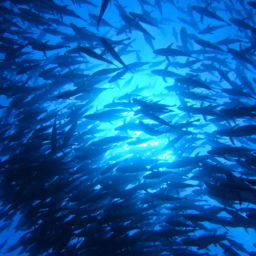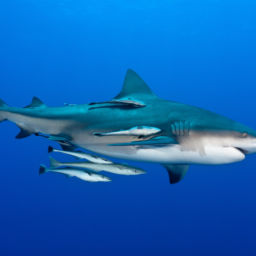My heart pounded as the choppy ocean slapped me in the face repeatedly. My mask fogged up like a coastal winter’s day in Cornwall. I was kicking like crazy as the Fijian waves threatened to dislodge my regulator and sense of dignity while I, a grown woman, prepared to cry and bolt to the dive boat. This was not my happy place. I was about to descend in Beqa Lagoon, the world’s reputed No.1 shark dive, and I just wanted to go home.
Diving Beqa Lagoon
Beqa Lagoon, just off Fiji’s largest island of Viti Levu, is renowned for its world-class shark diving. It’s home to the Shark Reef Marine Reserve and a healthy population of bull sharks. Beqa Adventure Divers (BAD) offers an opportunity to dive among these magnificent sharks within the marine reserve, and to also explore the reefs surrounding the shark-feeding station. The government established the reserve in April 2004, the first of its kind in Fiji. BAD is passionate about the conservation opportunities this reserve offers.
The shark-dive package consists of two dives. The journey to reach them is, in itself, interesting, as the boat navigates through the local mangroves before heading out to sea. The first dive begins at 100 feet (30 m). Divers kneel behind the feeding station and observe while the Divemasters attract the sharks with tuna heads and small fish scraps. An abundance of different reef fish species is hanging about and they disperse gracefully when the bulls arrive. In high season, divers can see more than 50 bull sharks. The dive center staff knows many of them individually. The sharks are confident and come within approximately 13 to 16 feet (4 to 5 m) of the divers while they feed.
After 15 minutes, the dive group ascends to 33 feet (10 m) to watch grey reef sharks at another feeding station. The reef sharks came particularly close during my dive and their proximity offered fantastic views of their markings and behavior. The final feeding station is at 16 feet (5 m), where divers take a lengthy safety stop while surrounded by whitetip and blacktip reef sharks, weaving among the bright coral reefs.
Up-close with bull sharks
After a surface interval on the boat, the second dive focused on a bull-shark feeding station 82 feet (25 m) deep. Since the water in Fiji is often crystal clear, it’s easy to descend without a rope or other aid. Divemasters instruct the guests to lie on their chests to allow the bulls to come closer. And it worked — the bulls passed overhead and mere inches from our faces. It is an exceptionally intimate encounter with these large sharks and is not in the least bit intimidating.
The shark dives with BAD are unique in that they are suitable for open-water divers despite their depth. The dive center has obtained special permission and insurance. This allows them to take OW divers along, and the dives themselves are run to a strict set of rules.
As for me, I needn’t have worried about the choppy waves or a fogged mask. The bulls were immense, blunt-nosed and stocky, yet calm and not the least bit intimidating. True to character, they were doing what sharks do best — pursuing their food and paying no attention whatsoever to humans. With nothing to fear, I leaned back onto my tank and enjoyed the show.



